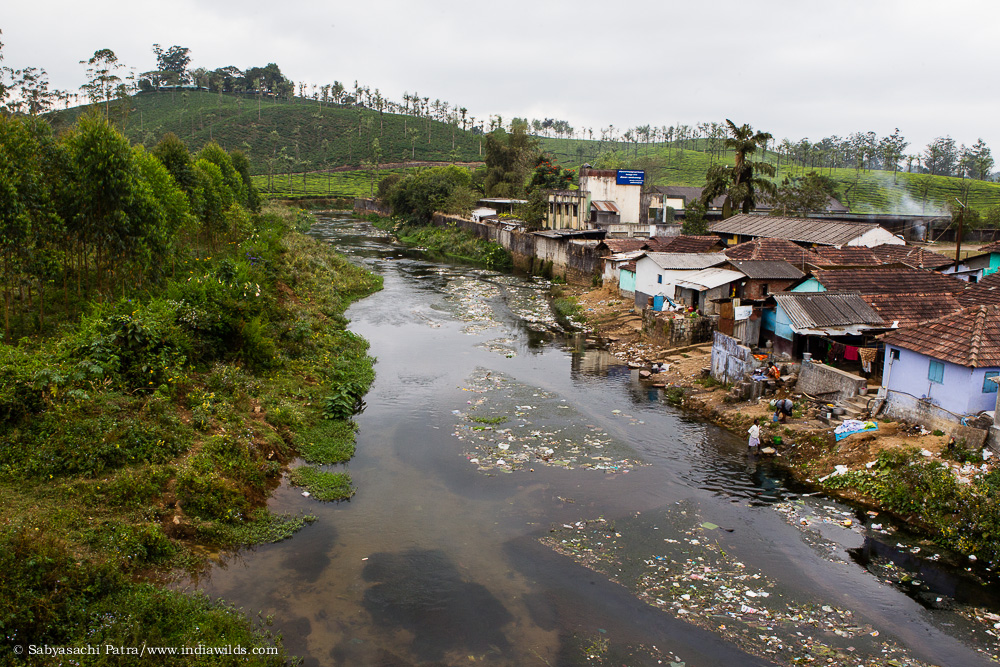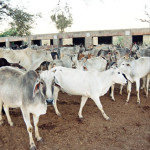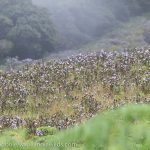IndiaWilds Newsletter Vol. 13 Issue V
ISSN 2394 – 6946
It’s time to adopt Wildlife friendly farming
More can be less. Less can be more. Big is not always better. Mankind has quickly forgotten these age-old sayings. It became especially true in the late 20th century when we changed our agricultural practices which set in motion a chain of reactions impacting our food, health, environment and wildlife.
Mechanised Farming, Synthetic Fertiliser & Pesticides:
When mechanised farming was introduced in India, people immediately thought that their traditional farm practices were bad because using a tractor one can plough a large area in the time taken by a farmer to plough a small field using bullocks. Productivity became the buzz word. Over a period of time all the traditional farming practices were abandoned, and India shifted to mechanized farming, and started using synthetic fertilisers, pesticides, hybrid seeds etc.
In the late 1960s, this new way of farming was quickly adopted in Punjab and in several parts of North Indian states like Punjab, Haryana and Uttar Pradesh quickly. overall production of grains shot up and it was branded and celebrated as Green revolution. Today after more than five decades, we have realised that the so called Green Revolution was not so green.
Leads to Cancer:
Excessive use of fertilisers and pesticides have turned the soil dead, ground waters polluted and farms barren. A large population is falling prey to Cancer. Every week people board a train from Bhatinda in Punjab to get down at Bikaner in Rajasthan for cancer treatment at close to free or nominal prices. This Abohar-Bikaner-Jodhpur train is so popular that it has been branded as Cancer Express.
The soil which metaphorically used to produce gold has now become the messenger of death. A study by Greenpeace found high incidence of pesticide residues in tea. (https://www.indiawilds.com/diary/indiawilds-newsletter-vol-6-issue-viii/, IndiaWilds August 2014). Out of 49 samples picked from the market, 34 samples had atleast one pesticide and 29 samples ie. 59% of all samples had more than 10 pesticide residues above EU (European Union) limits. Acephate and Monocrotophos affects the nervous system, highly toxic DDT and endosulfan were also found.
Organic Pesticides:
On the other hand, unlike claims by the pesticide lobby that synthetic pesticides have to be used to get rid of pests, there have been many indigenous solutions. On condition of anonymity, officials of Ministry of Chemicals and Fertilisers have said that the ministry had carried out tests of neem based pesticides in several tea plantations in Valparai and in surrounding regions of Tamil Nadu and Kerala. The neem based pesticides worked very well. An even more encouraging finding was that it helped in soil regeneration as well ie. it also acted as fertilizer. Nevertheless, not much work has happened on it.
Why Fertiliser Subsidy?
The practice of modern agriculture is still being promoted by MNCs, synthetic fertilizer and pesticide lobbies. The Government of India gives huge fertilizer subsidies. For the FY 22 the kept the fertilizer bill to India Govt. is a massive 88000 crore rupees. One may wonder why?
The Economic Survey FY16 had some interesting insights which can throw light on why the Government continues to make provision for an ever increasing fertilizer subsidy bill. According to the survey report, 41% of the subsidy is diverted for non-agri uses which includes smuggling to neighbouring countries. 24% is spent by farmers with large landholdings. A huge 24% of the subsidy is spent on inefficient producers. This is happening under the existing system of routing subsidy through producers. For gas, pension and other things the Government prefers to credit money directly to the bank accounts of people. However, for fertilizer subsidy why the Government directly gives money to producers instead of transferring it to individuals should be an easy guess.
Diabetes:
There was also great emphasis placed on using hybrid seeds instead of indigenous seeds. In the ‘60s the focus was on increasing productivity of the crops. So lot of research effort was directed at creating high yielding varieties of crops, especially that of wheat, maize and rice. This resulted in surplus stock and India becoming a net exporter of wheat and rice. This also resulted in a transition of people from consuming complex carbohydrates from traditional crops like millet, barley, sorghum and amaranth to foods with high glycemic index like wheat and rice leading to higher incidence of diabetes. “Today, the typical diet of an Indian is of high carbohydrate and low protein since the majority of consumers prefer rice and wheat in their diet. This transition in nutrition from complex carbohydrates of indigenous crops to high glycemic index foods such as wheat and rice is correlated with the incidence of diabetes mellitus. The incidence of diabetes in India is growing exponentially and to combat it, a demand for food containing complex carbohydrates with a higher level of dietary fiber is needed.” (A Review on Green Revolution, Nutritional Transition, Diabetes and Millet Movement in India; The Indian Journal of Nutrition and Dietetics; Pandian Arun et al., Oct 2019)
Wheat & Diabetes:
Wheat has complex carbohydrates and 75 percent of it is Amylopectin and 25 percent is a linear chain of Amylose. Both the Amylopectin and Amylose are digested by the enzyme Amylase but the amylose is not efficiently digested. “Amylopectin is efficiently digested by amylase to glucose… Thus, the complex carbohydrate amylopectin is rapidly converted to glucose and absorbed into the bloodstream and, because it is most efficiently digested, is mainly responsible for wheat’s blood-sugar-increasing effect.” (Wheat: The Unhealthy Whole Grain; Life Extension Magazine, Dr. William Davis, Oct 2011).
The effort to create high yielding hybrids of wheat has led to creation of plants which are dwarf or smaller in size with thick stalks that can handle the higher weights. This has lead to increase in the chain of branching glucose units Amylopectin in the wheat and is causing higher incidence of diabetes.
As per International Diabetes Federation (IDA) in the year 2017, approximately 72 million people in India were diabetics and this number will grow to 87 million by 2030. So we the people have to be aware of this.
The Government of India has to realise that this change in agri practices have led to huge impact on our health with increased incidences of diseases like diabetes and cancer and also has led to poisoning of our soil and water. So instead of focusing on these synthetic mechanized farming methods we need to focus on the traditional organic farming which Indians had been practicing for centuries.
Smaller fields & Insectivorous birds:
Scientific studies are now showing the benefits of organic farming. To help in mechanized farming large land parcels were created by merging the smaller farmlands. However, the traditional farms divided into smaller plots had a science behind it. The fields were lined up with flowering and fruiting bushes which used to attract birds and bees and used to serve as perch for insectivorous birds. The insectivorous birds used to easily fly from these perches and catch insects from the crops and then come back to their perch. With large fields it becomes difficult for the drongos, warblers, beeeaters and other such birds to fly large distances. They also expend way more energy flying longer distances for smaller prey and hence can’t cover the bigger fields.
Modern farming brought in the notion that every inch of land needs to be cultivated or else was counted as waste. Tractors and other mechanized farming equipment made people feel that they can plough all the area. Hence all bushes and trees were cleared off from the fields to create a large cultivable area.
Wildlife-friendly farming:
A study published in Proceedings of the Royal Society Biological Sciences has found benefits of using wildlife-friendly farming practices which improves crop yields. (Wildlife-friendly farming increases crop yield: evidence for ecological intensification; Pywell, Richard F. et al.; https://doi.org/10.1098/rspb.2015.1740 ). In a six year experiment, scientists “replicated two treatments removing 3 or 8% of land at the field edge from production to create wildlife habitat in 50–60 ha patches over a 900 ha commercial arable farm in central England, and compared these to a business as usual control (no land removed). In the control fields, crop yields were reduced by as much as 38% at the field edge. Habitat creation in these lower yielding areas led to increased yield in the cropped areas of the fields, and this positive effect became more pronounced over 6 years. As a consequence, yields at the field scale were maintained—and, indeed, enhanced for some crops—despite the loss of cropland for habitat creation. These results suggested that over a 5-year crop rotation, there would be no adverse impact on overall yield in terms of monetary value or nutritional energy. This study provides a clear demonstration that wildlife-friendly management which supports ecosystem services is compatible with, and can even increase, crop yields.”
The scientists also found that “in particular, habitat management practices, both in- and off-field, can support taxa that potentially provide services which enhance food production, such as native pollinators and predators of crop pests”.
There is some amount of lower crop yield in the field edge due to wild animals. There is always predator-vs-prey equations in nature. When wild animals use the area, it ultimately result is enrichment of the soil through excreta/dung and remains of wildlife carcass decomposing and nutrient recycling. There is a chain of complex ecological relations that come into play when wildlife habitat is created around fields and allowed to remain for several years.
Farmers associations/cooperatives and local NGOs can play a big role in facilitating conversion of existing agricultural fields to create wildlife-friendly habitats for ecological intensification resulting in more yields and better environment. Mapping the local fields to create a plan, of leaving some fields fallow and create wildlife habitat and equitably distributing produce over the rest will help in people agreeing to adopt this idea. It takes time for wildlife to slowly start appearing in a habitat. Hence, any agreements with stakeholders should be done for atleast 5 years so that one can see the benefits more in the later years when the habitat gets modified and becomes suitable for wildlife use.
We have poisoned our earth for too long and in the process poisoned ourselves as well along with our rivers, lakes, ponds and air. We have understood that each of our actions result in not only impacting ourselves but also every other species around us. God has given us the ability to create as well as to destroy. Let us wake up from our folly and start changing ourselves and our practices. Nature will heal on its own.
Conservation News:
Cheetah reintroduction
Reintroduction of exotic African Cheetah will finally be a reality in India this November. Cheetah, the world’s fastest land animal has two species – the Asiatic cheetah and the African cheetah. The Asiatic Cheetah was declared extinct from India in 1952 when the last three were shot by a Maharaja who knew no better.
A plan was introduced by a few scientists to reintroduce the African cheetah in India. This was striked down by the Supreme Court. However, after a change in Government and Justices, another bench of Supreme Court agreed with the Government. This is despite many conservationists and biologists of repute petitioning the Supreme Court in the past that the African Cheetah and Indian Cheetah are different and reintroduction of African cheetah which is an alien species doesn’t have any conservation value. However, the Wildlife Institute of India (WII) which in the last few years have backed every decision of Government to destroy/divert forest areas for dams, roads etc is expectedly a backer of this alien species reintroduction project. Unfortunately, tourism trumps over conservation. So instead of conserving habitat, the Government is focusing on exotic species reintroduction projects.
The Gujarat Government under the then CM Narendra Modi had disagreed to allow relocation of lions from Gujarat to Kuno wildlife sanctuary in Madhya Pradesh. The Lion relocation project was started after experts called for creation of a second home for lions as one epidemic can swiftly wipe out an entire population in an area. Madhya Pradesh Government had relocated villagers out of Kuno wildlife sanctuary and had prepared the place for reintroduction of lions from Gujarat. However, despite verdict of Supreme Court, the Gujarat Government didn’t agree. After election of Narendra Modi as Prime Minister in 2014, the lion reintroduction project went into cold storage.
Now the Government has decided to allow this controversial alien African cheetah’s to Kuno wildlife sanctuary in Madhya Pradesh, where Asiatic lions were supposed to be introduced. Perhaps with this move, the Madhya Pradesh Government will not ask for lion reintroduction in Kuno anymore.
It is said that 10 exotic African cheetahs will be brought in from South Africa and kept in an enclosure in Kuno. To help in this process, officials will be sent to South Africa to undergo training. The Cheetahs are planned to be shifted later this year in October and November.
Radio-collared tigress dead
A radio-collared tigress in Panna has been found dead. This tigress code named as P-213 was found dead on 15th of May in Gahrighat range of Panna National Park.
According to the forest officials they had noticed a swelling in the left leg on 12th of May and after tranquilisation the tigress was given treatment. Later the tigress was released back in the wild. Whether the health of the tigress deteriorated due to any lapse in treatment including higher tranquilising dose is not known. The forest department though maintains that this is a natural death.
This marks the fourth tiger death in Madhya Pradesh this month. On 7th May the carcass of a dead sub adult tiger was found on a canal Balaghat’s Waraseoni tehsil. Tigers are great swimmers so one does not expect a tiger to die of drowning.
On 8th May, a tiger death was discovered in Kanha. On 14th May a decomposed carcass was found in the buffer zone of Bandhavgarh. These are premier tiger reserves. It takes couple of days for a body to decompose. The fact that the forest department can’t immediately find if a tiger has died points out to the lack of patrolling of our forests. In the time of covid-19 when there is no tourism pressure, forest department officials, guards and watchers should have focused on patrolling. There have been many reports of poachers increasing their activity. However, forest department perhaps has some other priorities than guarding our natural heritage.
A month hasn’t passed and 4 tigers have been found dead. There may be some which were not noticed. At this rate more than 10% of the 526 tigers of Madhya Pradesh can die in a year.
Asiatic Lions housed in Hyderabad zoo infected with SARS-COV2 recovering well
On the 24th April 2021 with an abundance of caution, Nehru Zoological Park (NZP), Hyderabad shared samples (as collected from nose, throat and respiratory tract under anaesthesia) with CCMB-LaCONES for eight Asiatic lions housed in the Zoo that had showed signs of respiratory distress. Based on detailed diagnostic tests and report as shared by CCMB-LaCONES on 4th May 2021, it has now been confirmed that eight Asiatic lions housed in Nehru Zoological Park (NZP), Hyderabad have tested positive for SARS-CoV2 virus.
Further analyses of the samples have revealed that the infection was not caused by any variant of concern. The eight lions have been isolated and due care and necessary treatment has been provided. All the eight lions have responded well to the treatment and recovering. They are behaving normally and eating well. Preventive measures are already in place for all zoo staff and the zoo has been closed to visitors to avoid minimal external contact.
Central Zoo Authority has taken several pre-emptive measures including issuance of guidelines and advisories to the zoos towards precautions to be undertaken by zoos in the light of increasing number of cases of SARS CoV-2.
The monitoring and guidelines for prevention, sample collection, detection in suspected cases, and safety protocols for animal keepers etc have been suggested to zoos in consultation with scientific agencies and experts Indian Veterinary Research Institute (IVRI) Uttar Pradesh and Centre for Cellular and Molecular Biology – Laboratory for Conservation of Endangered Species (CCMB-LaCONES) Hyderabad. Such advisories are readily available in public domain http://cza.nic.in/news/en .
As part of next steps new guidelines for COVID precautions are being further developed in consultation with experts.
The Government has also advised media not to create panic through reporting of this incident.
India Biodiversity Awards 2021
Winners of India Biodiversity awards for 2021 were announced in a virtual function on 22nd May to celebrate International Day for Biological Diversity.
The India Biodiversity Awards initiative was started in the year 2012 by Ministry of Environment, Forests & Climate change (MoEF&CC); National Biodiversity Authority (NBA) and United Nations Development Programme (UNDP). This is awarded to recognise and honour outstanding models from grassroot level for biodiversity conservation, sustainable use of biological resources and governance.
The United Nations General Assembly in December 2000, had adopted May 22 as International Day for Biological Diversity. Since then every year on 22nd May the International Day for Biological Diversity is celebrated globally. This helps in raising awareness about the issue of a significant reduction in biological diversity due to anthropogenic activities. Hence the awards were given in a virtual ceremony on 22nd May, 2021. The awards carry a cash prize of Rs. Two lakhs and a citation.
The theme of 2021 was “We’re part of the solution”. The slogan was chosen to be a continuation of the momentum generated last year under the over-arching theme, “Our solutions are in nature”, which served as a reminder that biodiversity remains the answer to several sustainable development challenges.
Khonoma Nature Conservation & Tragopan Sanctuary (KNCTS) has won the prestigious India Biodiversity Awards 2021 under the category “Sustainable Use of Biological Resources.” KNCTS was established on 11th December, 1998. Khonoma is an area known for endemism in many species of plants and animals. Khonoma is known for its unique and sustainable alder-based jhum cultivation which has been practiced since time immemorial. The village has been successfully conserving its forest and sustainably using its resources for the last two decades.
The Chief Minister of Nagaland expressed his congratulations via twitter. He wrote “Congratulations to Khonoma Nature Conservation & Tragopan Sanctuary (KNCTS) on winning the #IndiaBiodiversityAwards2021 under the category ‘Sustainable Use of Biological Resources’ by @moefcc. Proud of KNCTS for its community-led initiatives & best wishes for future endeavours,” chief minister Rio tweeted.”
Congratulations to Khonoma Nature Conservation & Tragopan Sanctuary (KNCTS) on winning the #IndiaBiodiversityAwards2021 under the category 'Sustainable Use of Biological Resources" by @moefcc. Proud of KNCTS for its community-led initiatives & best wishes for future endeavours. pic.twitter.com/mjvD0ZUYGZ
— Neiphiu Rio (@Neiphiu_Rio) May 23, 2021
Shaji N. M. has been awarded in the individual category of Conservation of domesticated species. He has been working to conserve around 200 species of tubers like colocasia, arrow root, sweet potato, lesser yam, greater yam, elephant foot yam, etc.
Krishi Avam Paristhitiki Vikas Sansthan (KRAPAVIS) won the award under the category ‘Sustainable Use of Biological Resources.’ KRAPAVIS won the prestigious award for its support to communities in restoring water harvesting structures, recharge wells & water tables. It also helped to plant a million trees of local varieties in Orans.
We hope these awards will help inspire many people who are silently working in the field to preserve the amazing biodiversity of India.
Equipment Discussions:
Panasonic announces development of GH6 camera
Panasonic has announced that it is developing the GH6 micro four thirds camera and will launch by end of 2021.
Panasonic launches GH5 Mark II camera
Panasonic has launched an updated version of its GH5 camera with wireless streaming.
The GH5 MarkII camera has a 20.3-megapixel Digital Live MOS Sensor with Anti-Reflective (A.R.) coating in micro four thirds format. The sensor size is 17.3 x 13 mm.
ISO sensitivity: 200 to 25600. In extended mode shoot in ISO 100 as well.
The GH5 Mark II will be able to shoot at 4K 60p at 4:2:0 at 10 bits and it has wireless streaming capability. It can simultaneously do external recording at 4:2:2 10 bit over HDMI while internally recording is done at 4:2:0 10 bit 4K 60p.
During the covid induced lockdown more and more people are moving into the wireless streaming space. So Panasonic is aiming to get some foothold in this space.
It doesn’t have any recording time limit restrictions. So one can use it for continuous shooting situations like events and documentaries.
The GH5 II uses a contrast detection type autofocus. It uses advanced deep learning technology so that it can identify people as well as fast moving animals and can recognise the face and eyes. Improved tracking performance quickly recognizes the face and eyes of moving subjects and the human body from a background of moving subjects.
It boasts of a Dual I.S. 2 system which combines the camera’s sensor-shift image stabilization technology with lens-based image stabilization to compensate for a broad range of movement types and renders sharper, clearer imagery. However, the Dual I.S. 2 system only works with compatible Lumix lenses featuring O.I.S. According to Panasonic, this image stabilisation system helps the GH5 Mark II to compensate for 6.5 stops of camera shake.
Price: $1697.99 US Dollars
Check beow link for more details –
Western Digital launches Sandisk Professional Brand
If you are a photographer or filmmaker then chances of using Sandisk brand is high. Western Digital which owns the sandisk brand has launched storage solutions in the name of Sandisk Professional. These are premium storage solutions and price is also expected to be higher. However, it is expected that after paying a premium price one should be able to depend on these Sandisk Professional cards, card readers, hard disks, RAIDs etc. Often we are not sure if and when something is going to fail and with it all our data can go down the drain. Lets hope that this premium brand will have bullet proof reliability. The range is going to be available by June.
For more details click below link –
https://www.indiawilds.com/forums/showthread.php?19938-Western-Digital-Debuts-SanDisk-Professional-Brand&p=90615#post90615
Natural History
COUNTRY NOTEBOOK: M. Krishnan: ‘Lost in moody introspection‘ shared By Saktipada Panigrahi
https://www.indiawilds.com/forums/showthread.php?8852-Country-notebook-m-krishnan&p=52685#post52685
Photography Tips – Learning Exposure
To make photography learning easier, we are creating a photography tutorial video series. The first part of photography tips is on learning exposure. Check it out in this link: https://youtu.be/PT3vvNIJx1g
Wildlife Photography
Tiger cub by Sabyasachi Patra
https://www.indiawilds.com/forums/showthread.php?19910-Tiger-cub-in-shade
Tiger by Shyamala Kumar
https://www.indiawilds.com/forums/showthread.php?19898-Just-a-big-Cat
Changeable Hawk Eagle dark-morph by Mrudul Godbole
https://www.indiawilds.com/forums/showthread.php?19903-Changeable-Hawk-Eagle-dark-morph
Orange-headed Thrush Female by Samrat Sarkar
https://www.indiawilds.com/forums/showthread.php?19901-Orange-headed-Thrush-Male-and-Fenale
Pair of Monitor Lizards by Shyamala Kumar
https://www.indiawilds.com/forums/showthread.php?19900-A-Pair-of-Monitor-Lizard
Mukaria genus(bamboo feeding leafhopper) by Prajwal Ullal
https://www.indiawilds.com/forums/showthread.php?19908-The-tiny-life-forms-of-Bamboo
This is the 149th issue of IndiaWilds Newsletter. An image of a tea plantation adorns the cover page of this issue. Too often we fall in love based on the beauty of something. However, we don’t realise that at times beauty can be superficial and can hide the toxicity within it.
When people visit a tea estate, looking at the green surroundings they feel happy. The tea bushes planted in neat rows and the leaves trimmed by big hedge cutters impart a tidy feeling. Together with the cool climate, people feel relaxed and think that at those places nature is at its best. However, people fail to notice the toxic pesticides sprayed on the tea bushes which not only kill all insects but also remain as residues in the tea and other foods that we consume. The synthetic fertilisers which are used for plant growth often poison the soil. Rain water wash away those pesticides and fertilisers and poison the ground water, ponds, streams and rivers.
People living in ecologically fragile areas should be taught on a priority basis to shift to organic farming so that our rivers and streams are not polluted at source. The pandemic has made many citydwellers become cautious about health. So it is time to make more people aware that through our actions in the agricultural fields we can save health as well as save our environment and wildlife.
http://www.indi
To post in the IndiaWilds forums, you can register free of cost using your Full Name as user id at:
http://www.indiawilds.com/forums/register.php
If you are already a member of IndiaWilds and have forgotten your user id and/or password you can mail to:
administrator@indiawilds.com
Regards,
Sabyasachi Patra
Profile | Contact Us | Facebook | Diary | Equipment reviews | Forums | IndiaWilds You Tube Channel
Please post your views and feedback in the comments below.
- Endangered Wild Buffalo of Kaziranga - 4 July,2024
- Leopards: The Last Stand Trailer 2 - 1 July,2024
- GoPro Hero 12 Black - 6 September,2023
















Congratulations for successful completion of 149th issue and a long journey of 13th year of the Indiawilds newsletter. This issue is very informative regarding adverse effects of synthetic fertilizers and pesticides leading to various health concerns in human beings. Thank you for your efforts to make awareness among people.